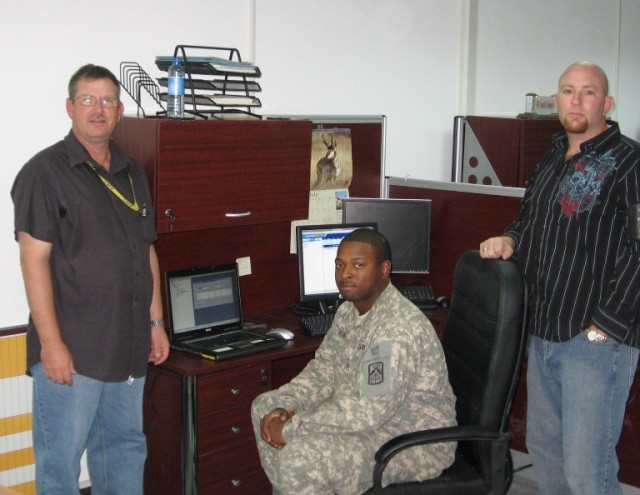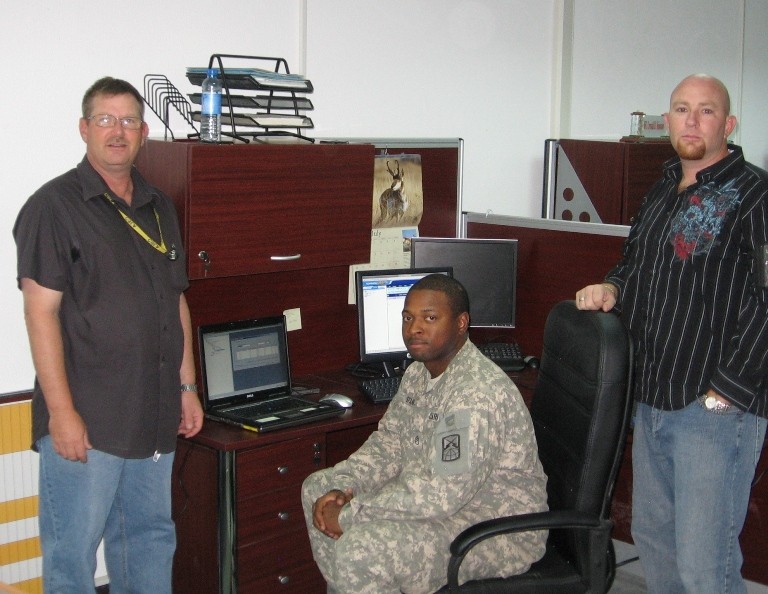FORT MONMOUTH, N.J. -- Whenever a Warfighter is required to drive through theatre in Iraq or Afghanistan, there is always risk involved, including the detonation of improvised explosive devices.
To avoid having to physically courier electronic encryption data known as encrypted key across the battlefield, Project Manager Warfighter Information Network-Tactical (PM WIN-T) has developed a new capability to send it electronically over the Secure Internet Protocol Router Network (SIPRNET).
"This capability will save lives while maintaining secure communications in theatre," said Ken Maloon, the project lead for Encrypted Key Distribution (EKD) over SIPR for Product Director Network Operations (PD NetOps) at PM WIN-T.
The encrypted key, also known as "black key," is a secure data stream that encrypts radio transmission and scrambles voice transmission so the enemy cannot decipher communications. An encryption key can either encrypt, decrypt or both.
Encryption turns information into unreadable cipher by applying a set of complex algorithms to the original material. A "key" is a piece of information (a secret parameter) that determines the functional output of a cryptographic algorithm. Because a key is typically a smaller piece of information than an encrypted algorithm, it is often easier to protect and to change if compromised.
The objective of the EKD over SIPR is to distribute a common encryption key across the battlefield area of operation in Iraq and Afghanistan.
The key travels from brigade and above where it is generated over an electronic means down to the company level and below. The operator will then download it into the Simple Key Loader (SKL), which loads the key into radios and other communications equipment. The intent is to prevent the Warfighter who is charged with managing and distributing the key from having to drive across dangerous battlefield terrain.
"By electronically distributing key, Soldiers can remain at their site and avoid the dangers of open theatre, thus reducing fatalities and saving lives," Maloon said.
In February 2009, after having improved the encrypted key over SIPR procedures and developed the training plan needed to implement the procedure effectively, a PD NetOps supported Mobile Training Team (MTT) from the Communications Security (COMSEC) Security Logistics Activity (CSLA) in Fort Huachuca, Ariz. went to Iraq to train the operators on EKD.
MTT instructors Miles Koenig and Guy Cook, responsible for conducting the training in Southwest Asia, have thus far successfully trained 140 personnel, including COMSEC Account Managers, SKL Users and COMSEC Hand Receipt Holders in transferring time sensitive mission critical COMSEC Key and Data over the SIPR Network.
The training was well received, said Maloon. The team was again deployed to Iraq and Afghanistan in August 2009 to provide the capability to newly deployed units. Once the training team leaves the units, PD NetOps is expecting that Army commanders in theatre will execute a train-the-trainer program. This will insure that those who were trained by the NetOps team will pass on the knowledge to their subordinates and new Soldiers.
"In order to sustain the use of EKD, it is imperative to continue training, and to reach the units before they are deployed," Maloon said.
PD NetOps is working in coordination with the Program Executive Office Command, Control, Communications-Tactical headquarters to integrate EKD into the Unit Set Fielding process. EKD will be included in the synchronization conferences to pre-deploying units to assure that those units are aware of the new capability and that they will receive training.
PD NetOps is also sending a training team to the Joint Readiness Training Center in Fort Polk, Louisiana, to train the evaluators located there. This will help them assess the competency of the units on EKD and the effectiveness of the training program. The long-range goal is to institutionalize the training and add it to the curriculum at the Signal Center in Fort Gordon, Ga., said Maloon. This will allow new Soldiers to receive the training prior to their first assignment.


Social Sharing